Big CC Racing have come up with a way to get extreme power out of the new KATANA by adding boost. Alan Dowds swapped his Kilt for leathers and broke speed limits... Test: Alan Dowds Photography: John Goodman.
Deny it all you like, but there’s something cool about the name of Suzuki’s KATANA. Sure, the original bike was a slick design, and the underlying performance was great for its day. But naming it after a killer ninja’s sword added an extra level of sweet style.
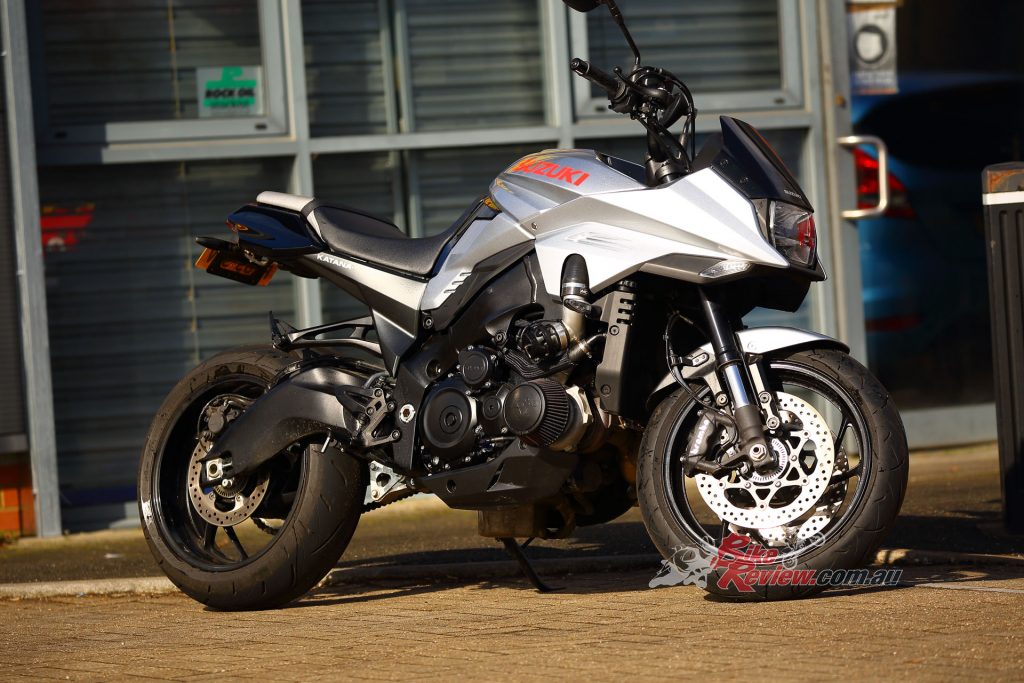
The new Suzuki KATANA is a beautiful bike that answered the prayers of every retro fan’s dream. What better way to turn it up a notch than fitting a turbo and making it into a rocket?
Forty years on though, things had changed a bit. Suzuki came out with a new KATANA, which was a good thing. But while it kept the sweet name and the styling was actually pretty good, the heart of the matter was a bit of a missed opportunity. Rather than taking the latest 2017 variable-valve GSX-R1000 and using that as a base for a 170bhp light supernaked, the firm had given the GSX-S1000 some new bodywork. The GSX-S is a good bike, for sure – but where the original KATANA rocked most folk’s world, the new one was a bit steady; more a hefty farmer’s machete than a super-sharp samurai sword.
Check out our test of the Big CC Z900 RS turbo build…
Enter Sean Mills, owner of Big CC Racing in the UK. Sean’s usual work is building engines for drag racers and land-speed-record attempts – with 500bhp turbo Hayabusas as the daily earner. He’s also got some previous with the old KATANA too – his suck-through turbo Spondon Katana drag race bike is a work of art that’s been in development for more than 20 years.
So it was only a matter of time before he got started on the new KATANA. He picked one up over the winter of 2019/20 for a good price, and got started during lockdown last year. The result is parked up in front of me outside the shop today – a super-subtle turbo install on an otherwise-stock 2020 KATANA.
Like his Z900 RS turbo build, this is a (comparatively) cheap and easy bolt-on turbo kit for the road. It’s a bit more complex than the Kawasaki though, because the KATANA engine has higher compression as standard – 12.2:1 as opposed to 10.8:1 on the Z900. That’s a bit too high for a turbo motor on pump fuel. Sean had the head and cylinders off, fitted a spacer plate under the cylinders, and slotted the camshaft sprockets to dial in the timing. It’s a much cheaper pathway than fitting low-compression turbo pistons – and since the conrods and bottom end remain standard, you wouldn’t be able to safely make the big power needed to justify aftermarket forged pistons either.
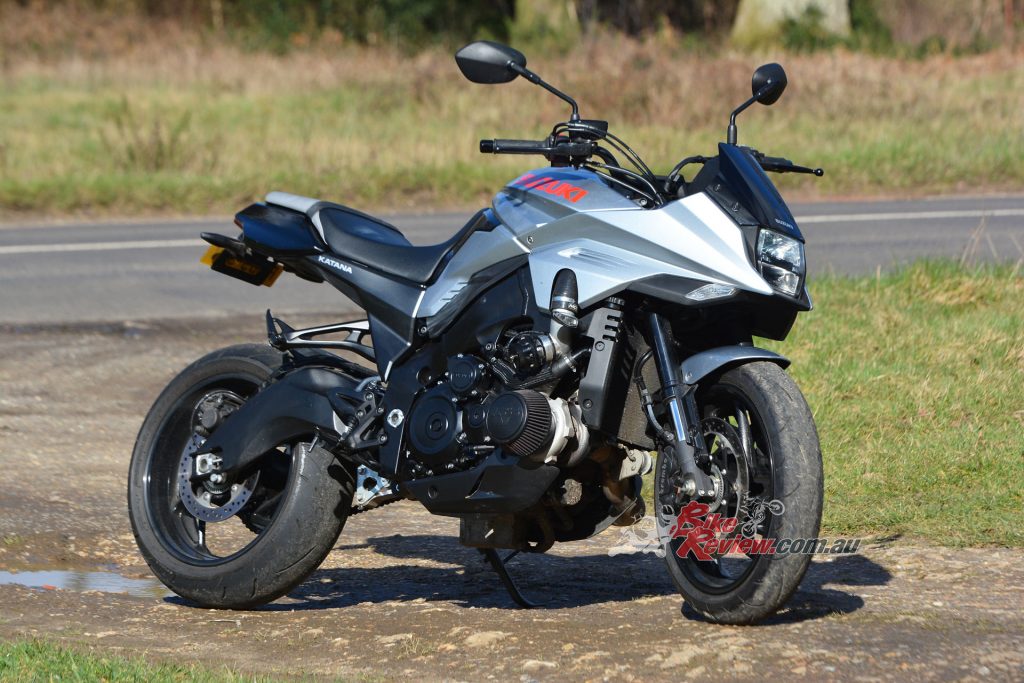
Only small adjustments were made to the engine to suit the turbo. Like a slightly lower compression ratio.
The engine was tweaked to suit and a fresh Garrett ball bearing turbo was matched up with a slick stainless manifold, Tial dump valve, fabricated plenum chamber – and that’s pretty much it. Fuelling is fixed by a Dynojet Power Commander and MAP sensor board under the pillion seat, a K&N pancake filter sits neatly on the side of the fairing, and a screamer of a turbo outlet pipe on the other side looks after both high-speed gas flow and high-decibel neighbour harassment duties. Boost control is the same hilarious manual dial as used on the Z900 RS – a simple anodised knob lets you choose between 220bhp and 260bhp boost levels.
THE WILD RIDE!
Things get serious quickly. The KATANA starts on the button, with an earth-shattering roar. The Z900 RS came with an end can, but this time it just has that simple race slash-cut dump pipe, so there’s nothing to silence the GSX-R-based engine apart from the turbine blades. A turbo does take a bit of energy out of the exhaust flow – but there’s still plenty to shatter the peace and quiet!
I pull away from Big CC, and notice that the fuel light is flashing. New KATANAS always need fuel to be fair, so we pull in at the first petrol station for some expensive super-unleaded, and a quick pressure top-up on the tyres (the steering felt a little heavy, thanks to just 20psi in the front…).
Now we’re set. The Big CC Suzuki is completely standard in chassis terms, right down to the (slightly worn) OE Dunlops, Sean obviously focussed on the engine work. Trundling through traffic on the way out of Wokingham would be much the same on a stocker. This situation does not last for long. We get to the first big clear dual carriageway out of town, and give her an handful in second gear.
Up until 5,500rpm, progress is brisk, but then at 6k, things go properly bonkers. Not in a scary, unpredictable, light-switch kinda fashion, but just a massive wave of relentless grunt that quickly builds and builds. The front-end comes up (traction control is off) and the speedo numbers are whizzing round like the proverbial fruit machine. Up a gear into third, and the same thing happens again – intoxicating acceleration, front wheel sailing skywards, and only a fast-approaching roundabout stops me changing up into fourth for more of the same…
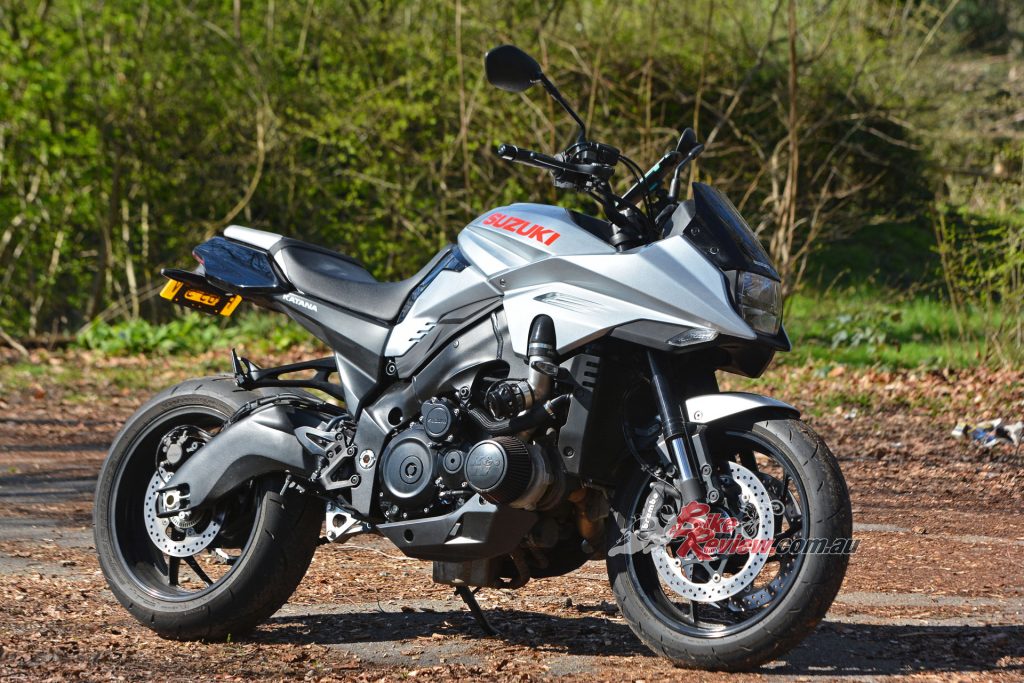
The BigCC KATANA looks just as striking standing still. With the factory lines and curved all preserved.
It’s a striking motor, and easily tops the very latest 1100cc superbikes for sheer unadulterated power. Even the new Hayabusa, which I rode a few weeks later, can’t quite match the mind-blowing nature of the KATANA’s turbocharged GSX-R1000-based engine. On the motorway, you can play silly games, seeing how fast it will accelerate between speed camera gantries, holding the throttle open fully for as long as you dare, giggling at the rush.
“Once you adapt and start using the power a little more, the front wheel barely touches the deck, it just skips along.”
I wasn’t sure if I preferred it over the Z900 RS tune from last year mind. The KATANA has a totally different feel from the hugely-torquey low-revving Kawasaki, with a bit of a wait before the big power kicks in – and arguably, the Z900’s instant drive just off idle and 200bhp peak power is better suited to the naked roadster format. The 150bhp tune of the stock KATANA motor is part of the reason – it’s a more powerful, higher-revving bike than the Z900 as standard.
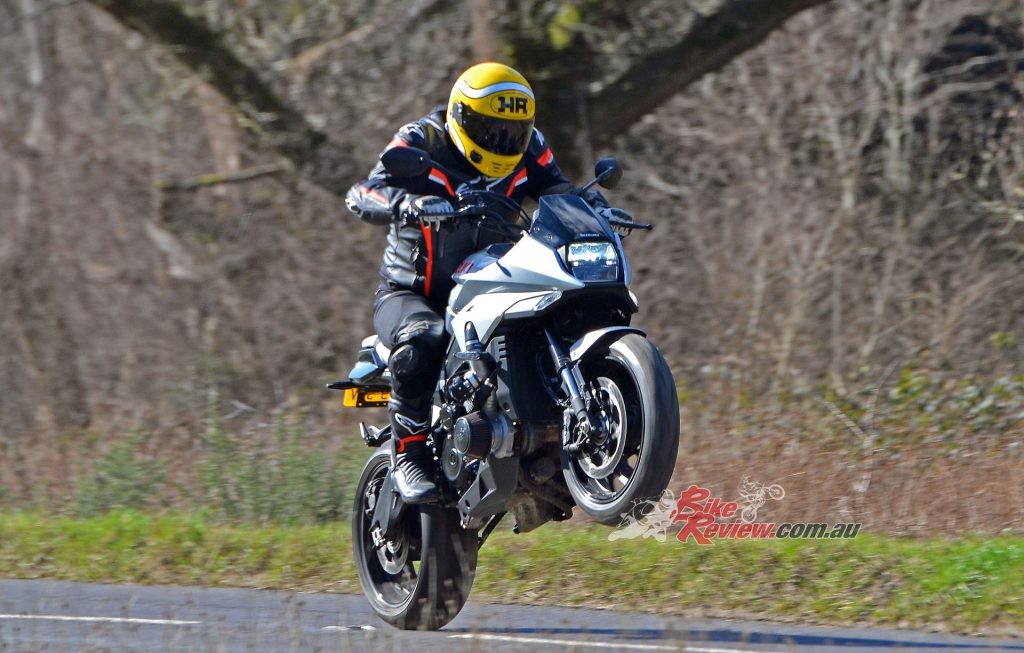
The power delivery high in the rev range made getting photos a little tricky. Too low of a gear would fling the wheel up quickly but higher gears meant you had to be going mach-10 to hold it up.
As it is, the delivery of the turbo power at a higher rev range makes it trickier to do silly things like slow wheelies for photos. Doing some for the camera was a bit of a handful – first gear was too sharp when the power hit, second or third gear was a bit too fast. The fuelling was a little tricky too – while riding normally it’s spot-on, and on full throttle there’s no grief at all.
“On the motorway, you can play silly games, seeing how fast it will accelerate between speed camera gantries, holding the throttle open fully for as long as you dare, giggling at the rush.”
But modulating the gas when the front end starts to come up is difficult – as you roll off, the power cuts sharply. Those minor gripes aside though, this genuine 250bhp+ powerplant definitely gives the KATANA something to shout about in terms of performance, besting even the wild Ducati Streetfighter V4 and Aprilia Tuono 1100 when it comes to ballistic levels of power.
Check out our other custom bike tests here…
When taking it through the corners, noise aside, we’re once more back on a stock KATANA. That means good brakes, decent road-bike suspension and steady, slightly portly handling. The KATANA is some way off something like a BMW S 1000 R or KTM SuperDuke if you want precise, lightweight supernaked handling – it’s maybe closer to the likes of a Kawasaki Z1000SX or Z H2. The extra weight of the turbo is offset by the missing stock exhaust system, so you’re at about the same as standard in terms of mass. The stock tyres aren’t amazing, and you can do better with some sportier aftermarket replacements of course – which I’d do straight away to be honest.
As it is, the KAT chassis is a decent base should you want to get stuck in with serious upgrades like lightweight wheels and suspension upgrades. Carbon or forged rims, a rear shock and fork revalve really would help get the most out of what is a solid base GSX-R1000-based frame and swingarm.
Adding a turbocharger and 100bhp+ to the new KATANA has not helped its marginal fuel range. Off-boost and trundling about, the consumption readout on the dash seems to be not too far off standard. But once you start spinning up the turbine, you can almost hear the tank being sucked dry. It’s one of those things – if you don’t mind stopping every 120km or so for a coffee and a chat with your mates then it won’t even be a factor for you to add fuel at the same time. The worst bit about the low fuel capacity is it’s not even something you could easily sort out – tyres, suspension, brakes, engine can all be swapped out or tuned up to your satisfaction.
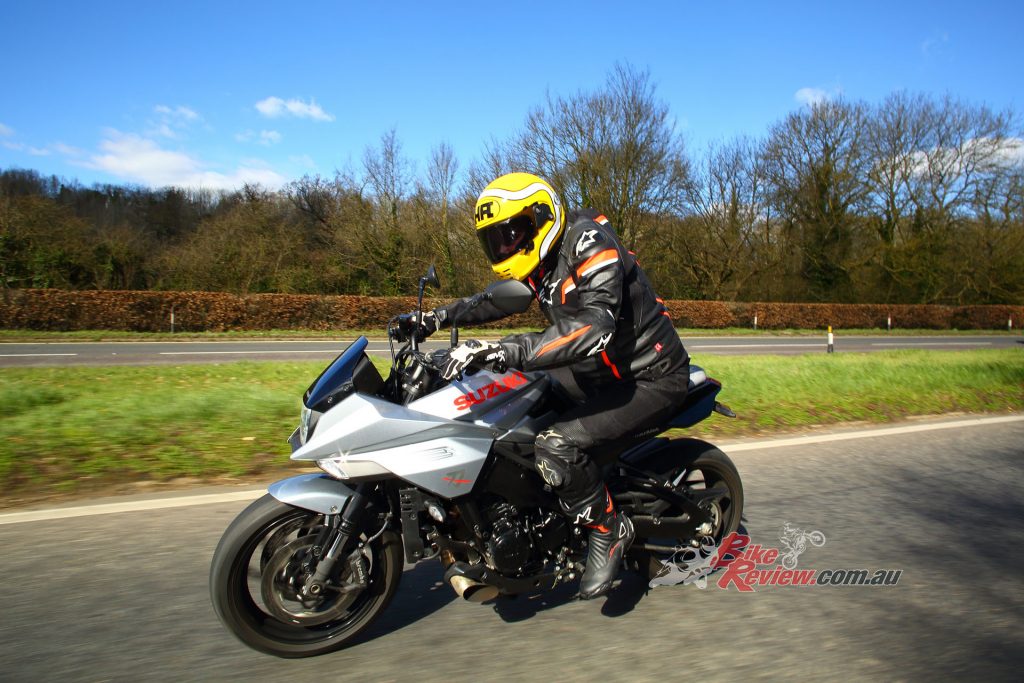
“Tank range is about the least cool thing you can talk about on a bike, especially one named after the KATANA”.
Of course, tank range is about the least cool thing you can talk about on a bike – especially one named after the KATANA. But then a turbocharger is probably about the coolest thing you can talk about on a bike. So we’re definitely calling this a win for the turbo KAT…
NUTS & BOLTS!
To keep costs down, Sean at Big CC has gone old-school on the engine mods, fitting a spacer plate under the cylinders to raise the block and head. That makes the combustion chamber volume larger, thus reducing the compression ratio.
The complication there is that the camchain run from crankshaft to camshafts is now a little longer, changing the valve timing ever so slightly. So, Sean has slots machined in the camshaft sprockets which allows him to move the cams and accurately adjust the valve timing to his settings.
It’s cheaper than fitting low-compression turbo pistons, though that is an option if you want to run more boost. The problem then is that the bottom end will start to hit the limit, so you’ll need billet conrods, lock-up clutch, billet crank, HD case bolts and studs. Then, you may as well fit a larger turbo, bigger injectors, uprated fuel pump and external wastegate while you’re at it, and before you know it you’ve spent $35k and accidentally built a 500bhp drag race motor.
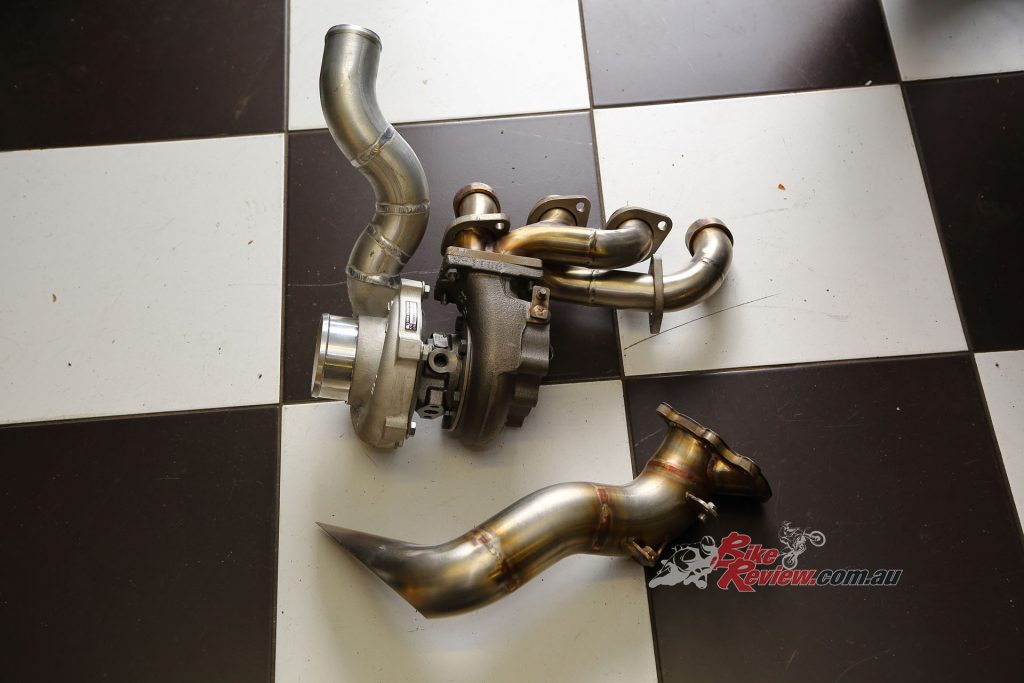
Turbo builds can get out of hand quickly when it comes to cost. Big CC will get you started with a simple exhaust manifold and Garrett ball bearing turbo.
A Garrett ball-bearing turbo that’s been modified to suit the GSX-S1000 and KATANA install, with internal wastegate. Needs pipework to the engine for oil feed and return, and is attached to a gorgeous handmade stainless manifold/header pipe. The test bike had a simple screamer exit pipe, but Big CC can supply a link pipe and end can at extra cost.
You can spend a lot of cash on fancy electronic boost controller solutions these days, but Sean has kept it simple here, with a manual boost dial. Simple turn the knob for more or less boost. Alloy link pipe leads to the under-tank plenum chamber. You can have either a simple fabricated plenum, or a fancy machined billet unit, depending on budget and later upgrade plans
Big CC has a load of overseas customers, so is well used to shipping the good stuff wherever it’s needed. If you’re outside the UK, they can send you the turbo kit with all you’ll need, and also provide full advice on fitting. Having said that it’s not really a novice spannering job, and you will want a dyno facility to optimise the final fuelling – so probably one for a proper tuning shop.
The basic cost for the turbo kit in a box is around AUD $6,400 and a silencer with link pipe would add around $900, depending on spec. If you’re in the UK Big CC can do the engine work (remove and refit motor, fit spacer plate, cam timing, gaskets) for another AUD $1,800 and the turbo kit installation would be AUD $1,450 (all plus local tax).
Big CC Suzuki Turbo KATANA Specifications
Engine: Liquid-cooled, four-stroke, forward-inclined parallel four-cylinder, four-valve per cylinder, DOHC, 73.4 x 59mm bore x stroke, 999cc, lowered compression, 44mm throttle-bodies, Garrett ball-bearing turbo, handmade stainless manifold/header pipe.
Chassis: FEM designed alloy frame, alloy braced swingarm
Rake: 25 degrees, Trail: 100mm.
SUSPENSION: 43mm KYB fully adjustable telescopic forks, 120mm travel, KYB rear shock, link type single shock, rebound and preload adjustment
Brakes: Bosch ABS system, Brembo radial-mount four-piston calipers, 310mm rotors, 220mm rear rotor with Nissin caliper, Nissin conventional master-cylinder
Performance: Roughly 220bhp and 260bhp depending on boost levels.
Alloy link pipe leads to the under-tank plenum chamber, Garrett ball-bearing turbo, Standard injectors and fuel pump, with a Dynojet Power Commander and external MAP sensor board.
Big CC Suzuki Turbo KATANA Gallery


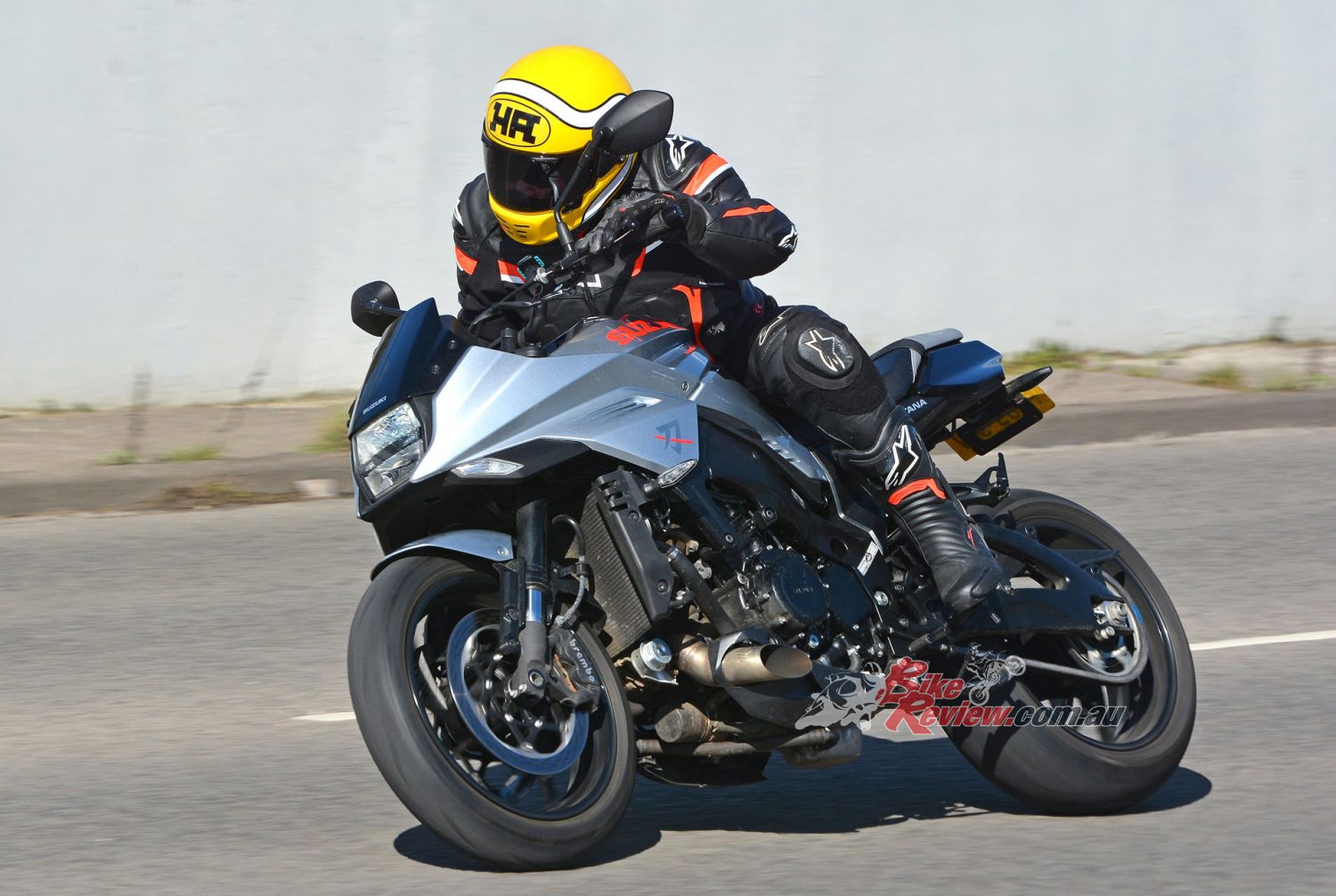
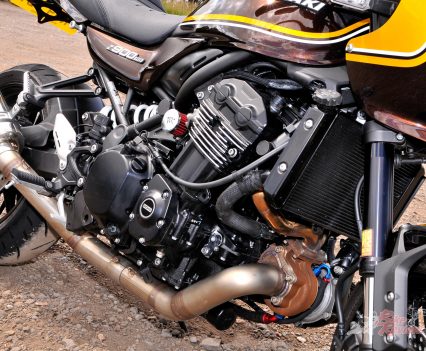
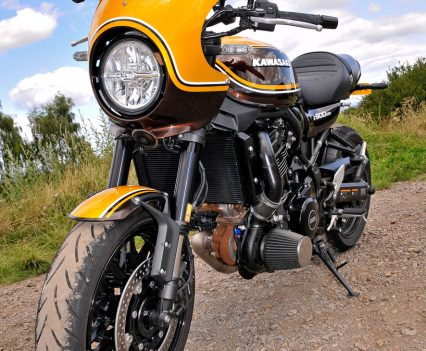
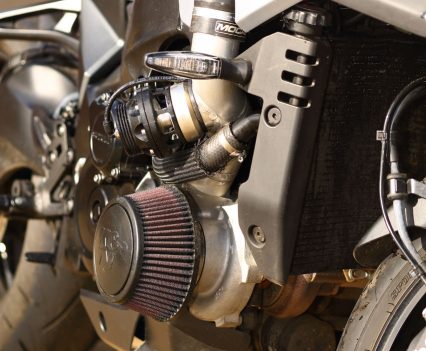
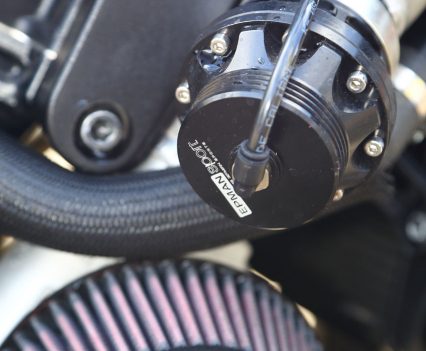
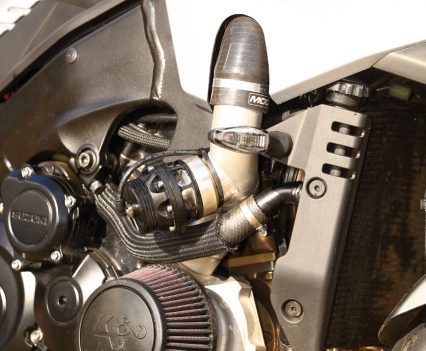
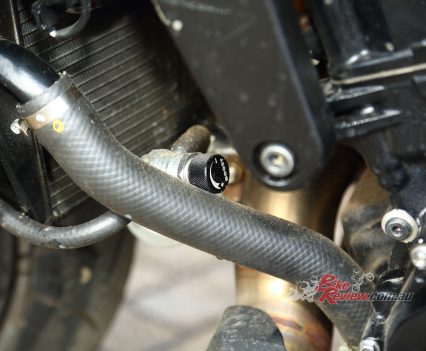
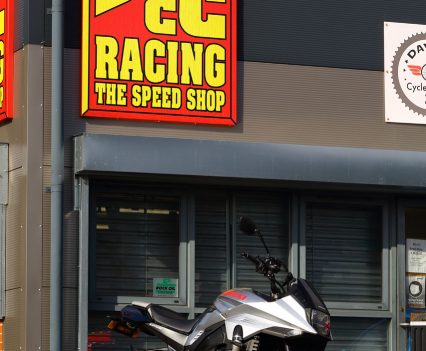
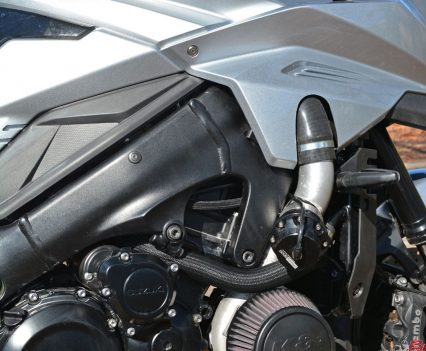
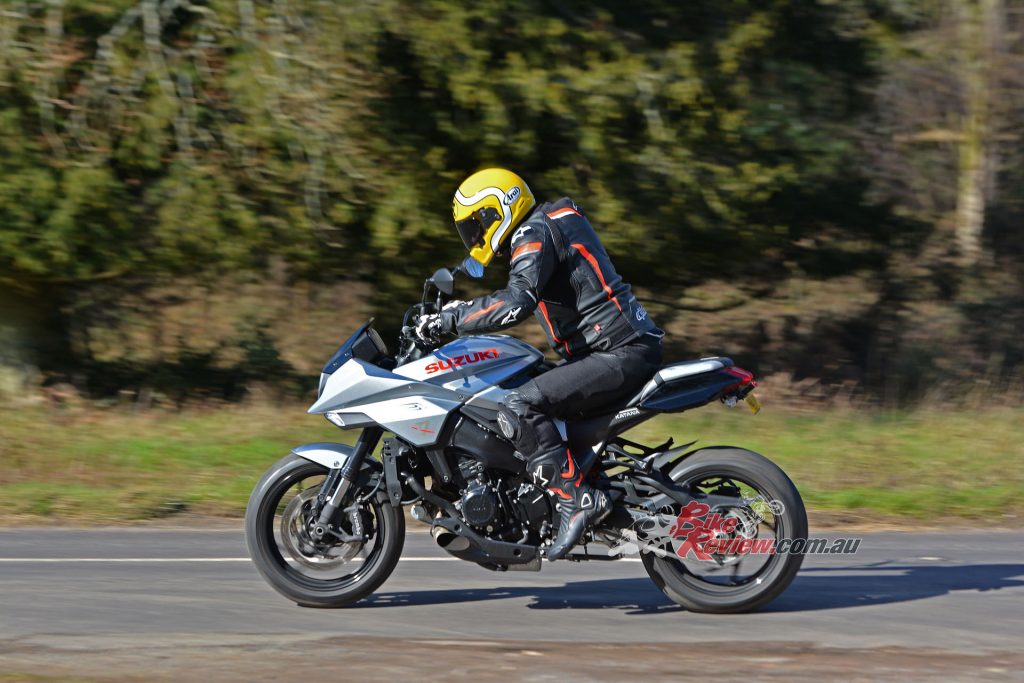
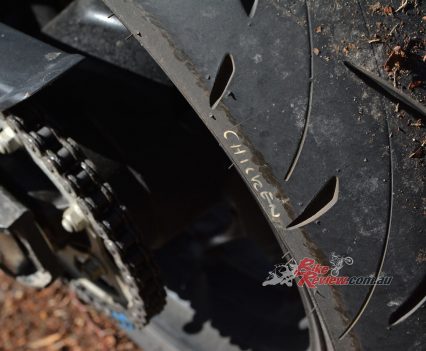
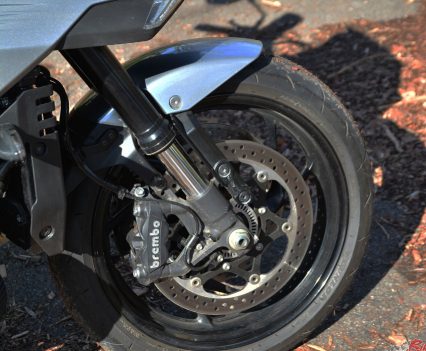
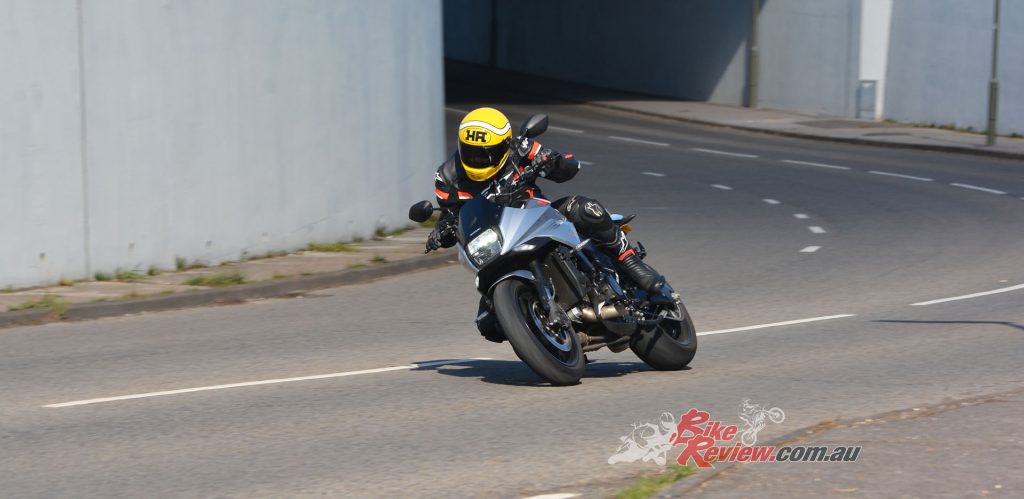
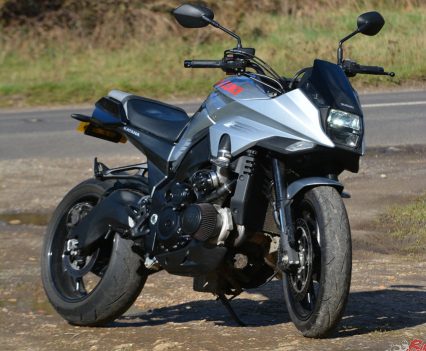
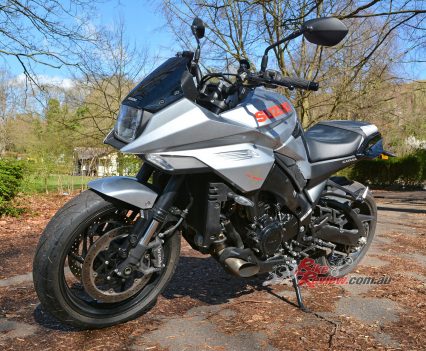

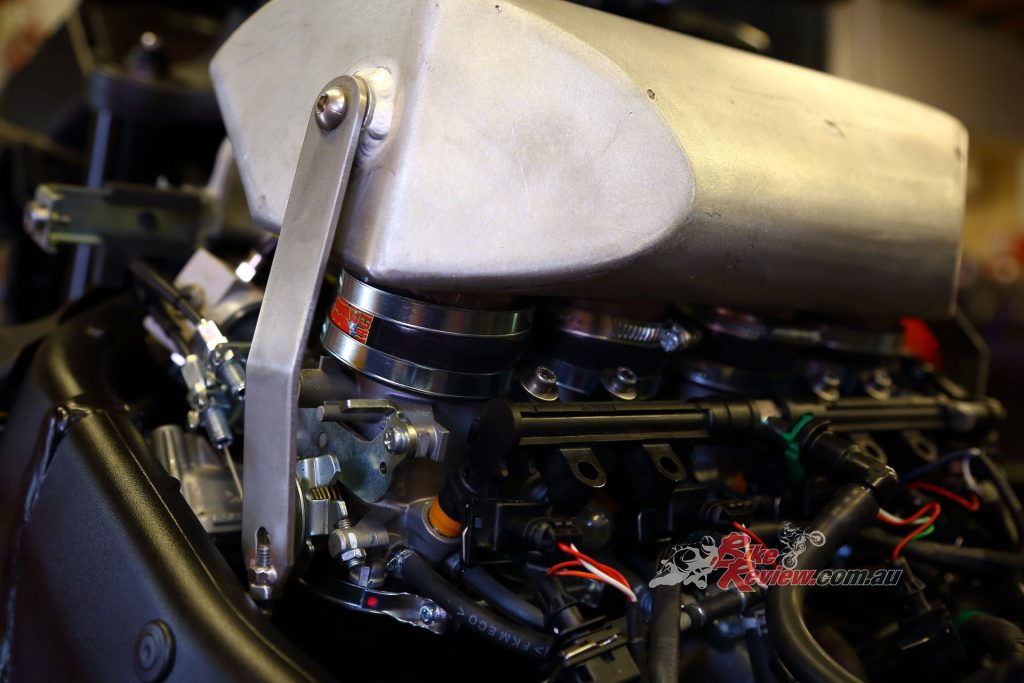
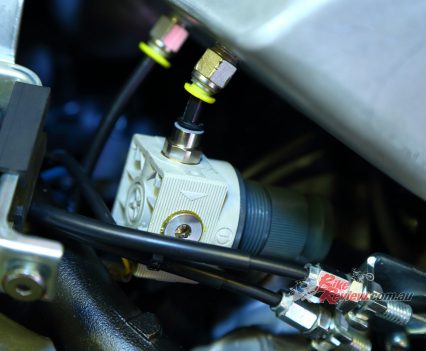
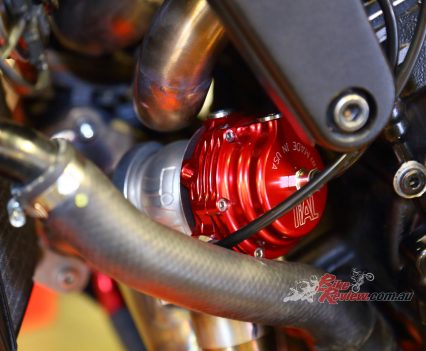
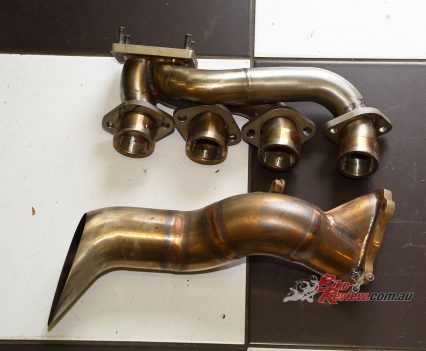
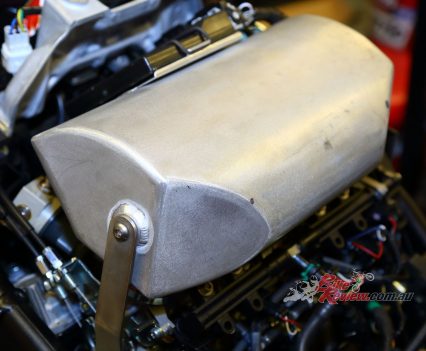
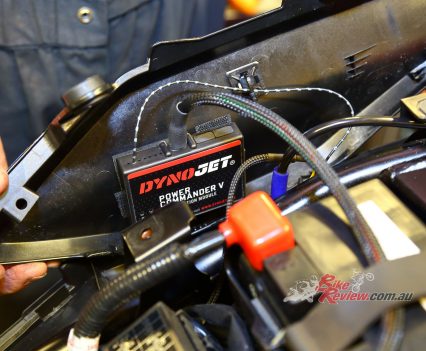
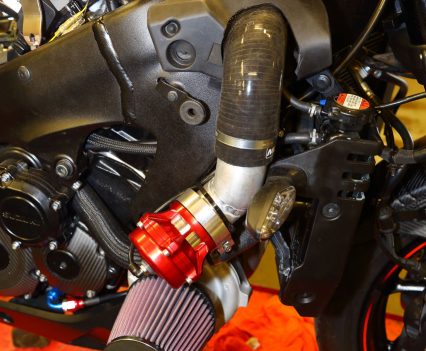
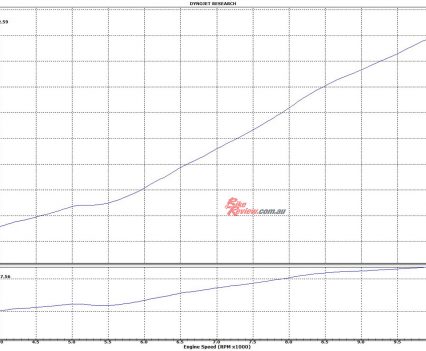
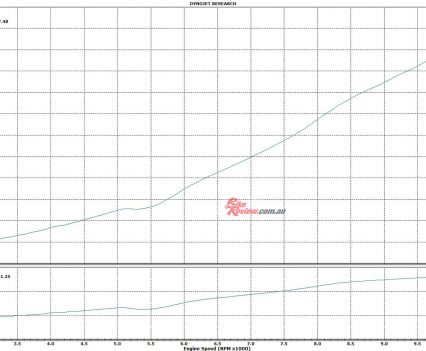


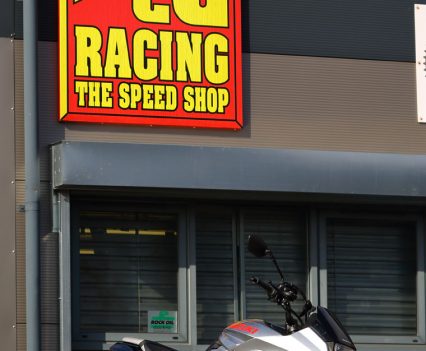
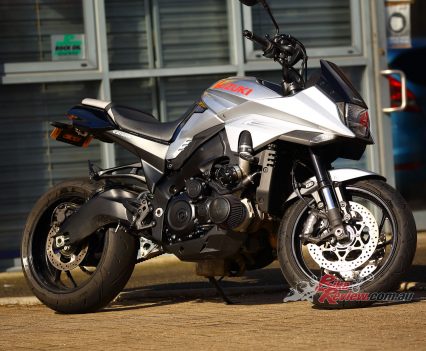
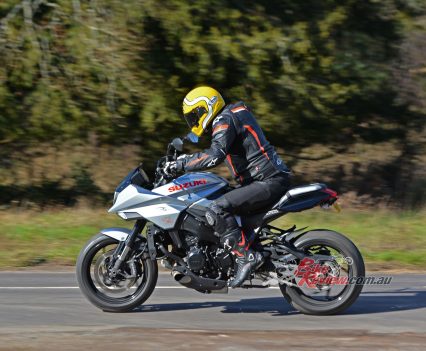
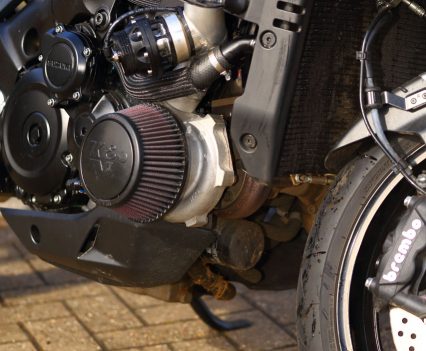
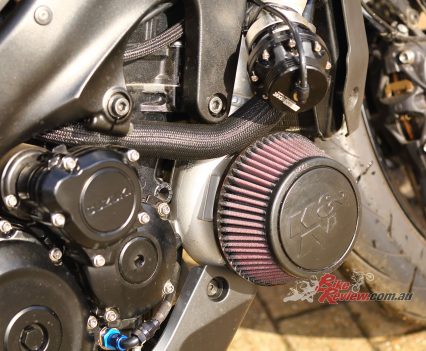
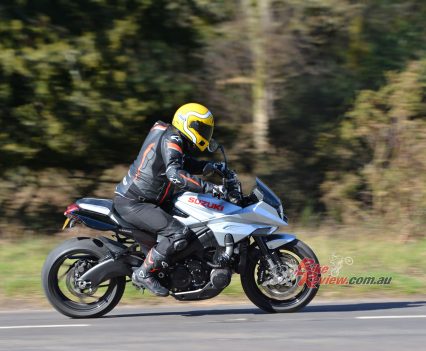
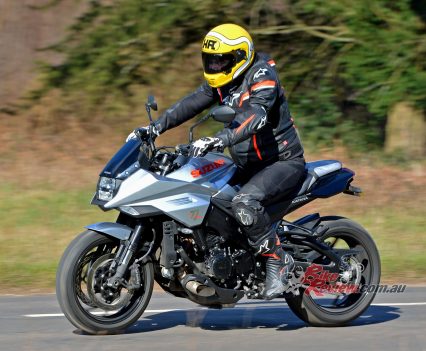
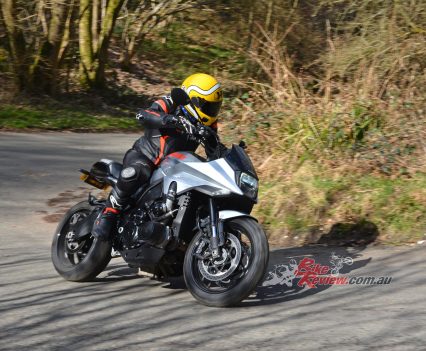
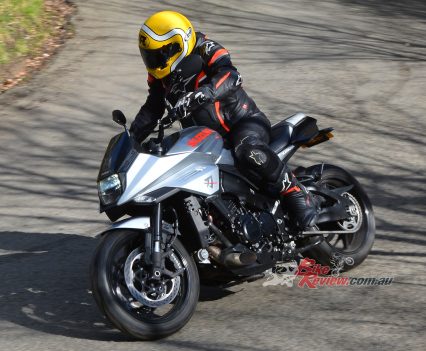
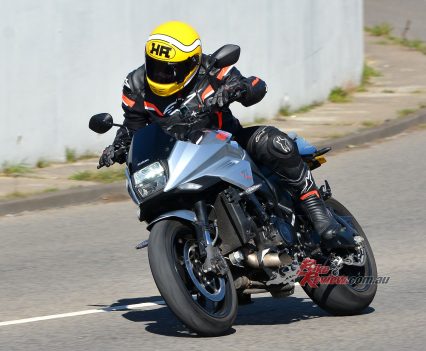
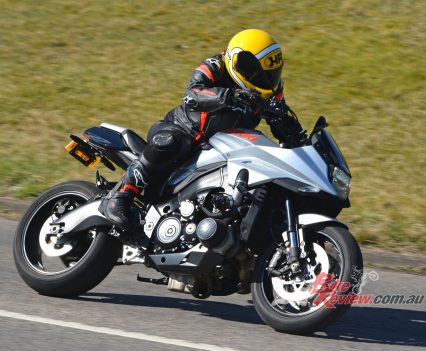
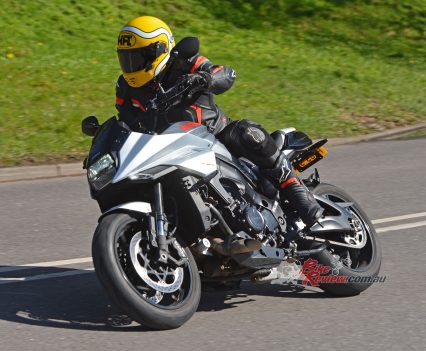
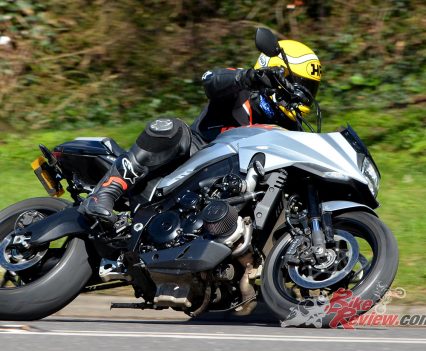
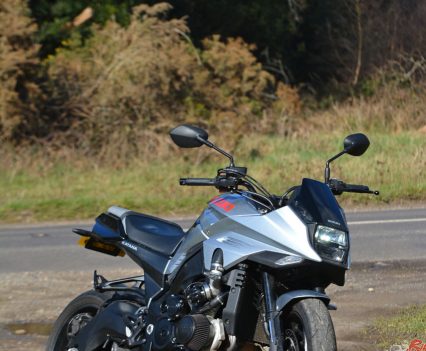
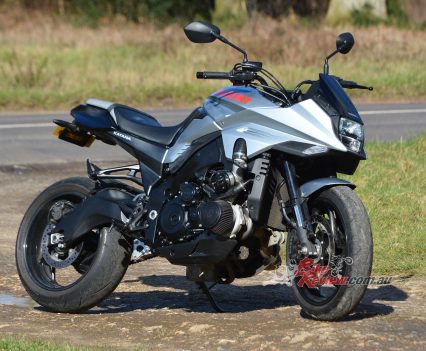
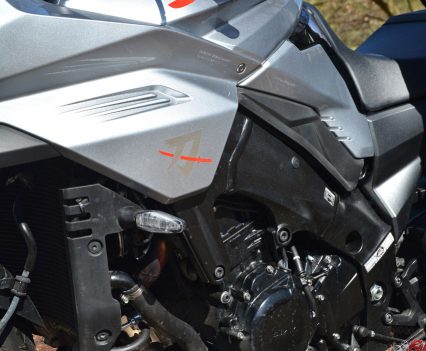
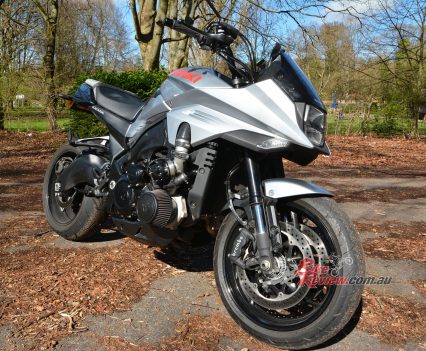
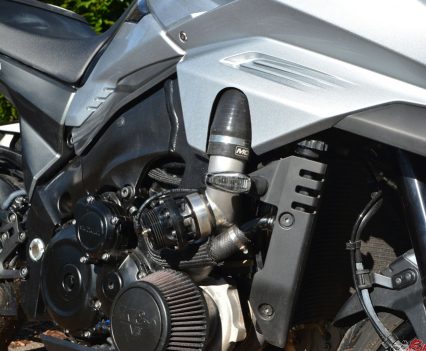
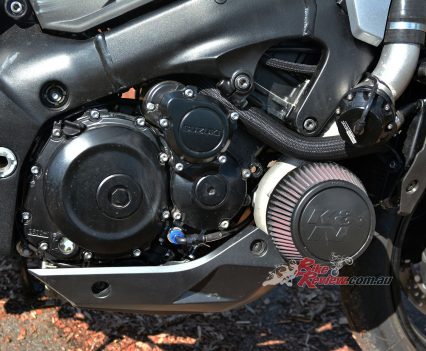
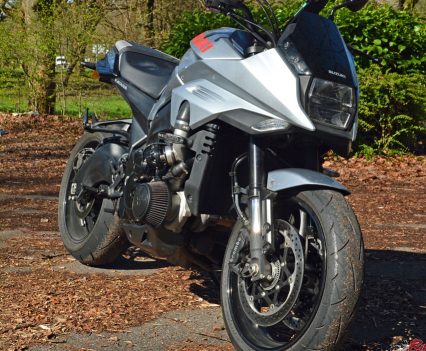
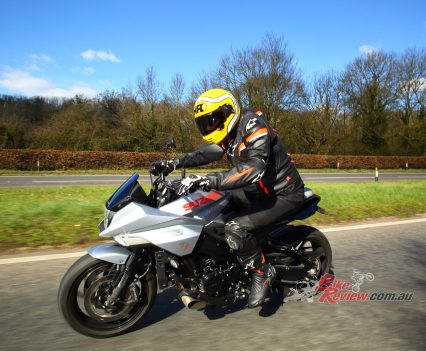
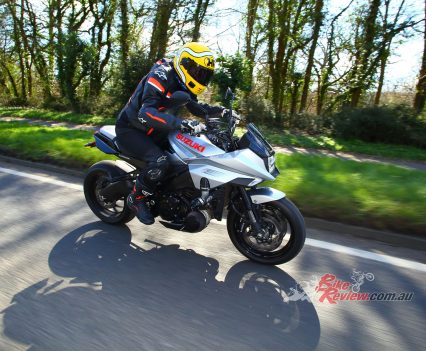
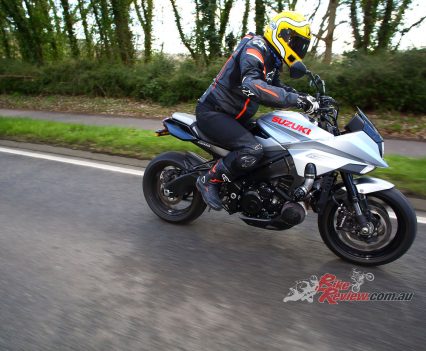
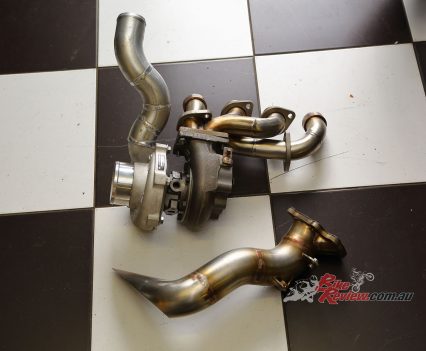
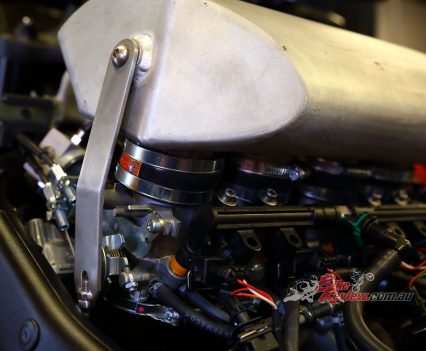
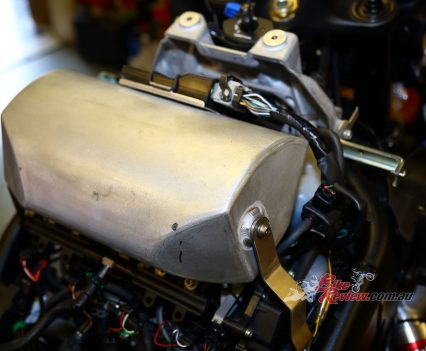
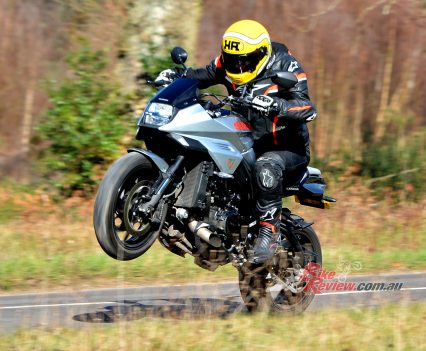
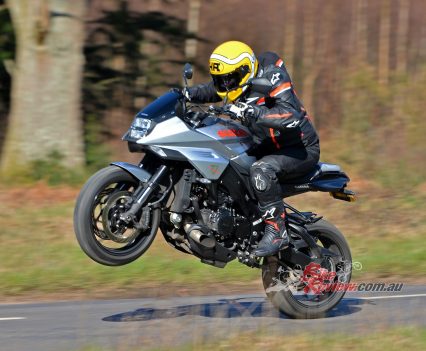
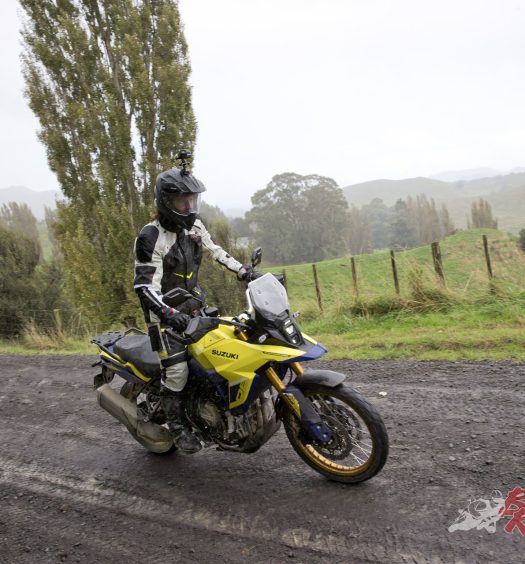
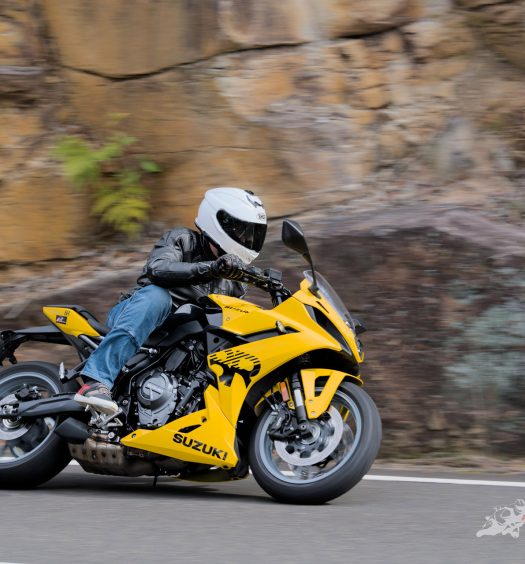













June 8, 2021
Alan is of course right about the wave of torque when the boost starts to build!
And I can tell everyone who’s not ridden a modern turbo bike as they all think it’s lag or all the power up the top, which is just not the case